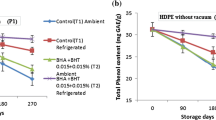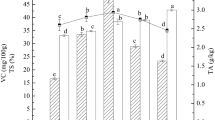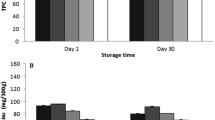Abstract
In this research, persimmon samples (sliced, pureed) were dehydrated by convective (50 and 100 °C) and microwave (100 W) drying techniques with different pre-treatment combinations of sugar addition (25%) and blanching (100 °C, 5 min). Each pre-treatment consisting of sugar addition, slicing, and blanching resulted in a significant increase in color parameters compared to unpretreated samples. Color parameters measured at low drying temperatures were lower than high ones. Also, 100 W dried samples were higher in total anthocyanin content, and the pureed samples were 24.80% higher than sliced ones. The bioactive potential was evaluated regarding extractable, hydrolysable, and bioaccessible phenolic fractions by total phenolic content and ABTS (2,2′-azinobis-(3-ethylbenzothiazoline-6-sulfonic acid), DPPH (2,2-diphenyl-1-picrylhydrazyl) and CUPRAC (Cupric Reducing Antioxidant Capacity) antioxidant capacity assays. (i) 50 °C drying prevailed on drying at 100 °C and 100 W, especially in terms of extractable phenolic fractions and bioaccessible phenolic fractions; (ii) Sliced samples were higher for EPF and BPF, while pureed ones were higher in hydrolysable phenolic fractions; (iii) Blanched samples were relatively higher than unblanched ones in total phenolic content. For antioxidant capacity assays, extractable phenolic fractions were higher in blanched samples and bioaccessible phenolic fractions in unblanched ones (TEACABTS, TEACCUPRAC). (iv) Sugar addition negatively affected the bioactive potential in persimmon samples; no-sugar-added samples were higher, especially in bioaccessible phenolic fractions (p < 0.01; Total phenolic content, TEACABTS, TEACCUPRAC). (v) The CUPRAC assay was the most appropriate method due to providing a view of more statistical distinction by picturing the same potential.
Similar content being viewed by others
Data availability
The datasets used in the current study are available from the corresponding author on reasonable request.
References
J. Kim, I.K. Chung, H.Y. Kim, K. Kim, Comparison of the quality of dried persimmon (Diospyros kaki) treated with medicinal plant extracts and food additives. Food. Sci. Nut. 6(8), 1991–1998 (2018). https://doi.org/10.1002/fsn3.673
U. Mehra, M. Negi, M. Awasthi, Effect of rooting media and indole-3-butyric acid on rooting of cuttings in persimmon (Diospyros kaki L.) cv. Fuyu. J. Pharmacogn. Phytochem. 8(3), 400–403 (2019)
C. Conesa, N. Laguarda-Miró, P. Fito, L. Seguí, Evaluation of persimmon (Diospyros kaki Thunb. Cv. Rojo Brillante) industrial residue as a source for value added products. Waste Biomass Valorization 11, 3749–3760 (2020). https://doi.org/10.1007/s12649-019-00621-0
K. Matsumoto, K. Masuda, K. Takekawa, T. Koyanagi, Influence of heat treatment on the bile acid binding ability of persimmon tannin-rich fiber and its application to a food material for breads. J. Japanese Soc. Food Sci. Technol. 61(11), 543–547 (2014). https://doi.org/10.3136/nskkk.61.543
C.C. Zhao, K. Ameer, J.B. Eun, Effects of various drying conditions and methods on drying kinetics and retention of bioactive compounds in sliced persimmon. LWT Food Sci. Technol. 143, 111149 (2021). https://doi.org/10.1016/j.lwt.2021.111149
W. Senadeera, G. Adiletta, B. Onal, M. Di Matteo, P. Russo, Influence of different hot air-drying temperatures on drying kinetics, shrinkage, and colour of persimmon slices. Foods 9(1), 101 (2020). https://doi.org/10.3390/foods9010101
I. Alibas, A. Yilmaz, B.B. Asik, H. Erdogan, Influence of drying methods on the nutrients, protein content and vitamin profile of basil leaves. J. Food Compost. Anal. 96, 103758 (2021). https://doi.org/10.1016/j.jfca.2020.103758
J.L.G. Corrêa, F.J. Lopes, R.E. de Mello Jr, J.R. de Jesusjunqueira, M.C. de Angelis Pereira, L.G.A. Salvio, Dried yacon with high fructooligosaccharide content. J. Food Process. Eng. 44(12), e13884 (2021). https://doi.org/10.1111/jfpe.13884
L.Z. Deng, A.S. Mujumdar, Q. Zhang, X.H. Yang, Z.A. Zheng, Z.J. Gao, H.W. Xiao, Chemical and physical pretreatments of fruits and vegetables: effects on drying characteristics and quality attributes-a comprehensive review. Crit. Rev. Food Sci. Nutr. 59(9), 1408–1432 (2019). https://doi.org/10.1080/10408398.2017.1409192
R.P. Kingsly, R.K. Goyal, M.R. Manikantan, S.M. Ilyas, Effects of pretreatments and drying air temperature on drying behavior of peach slice. Int. J. Food Sci. Technol. 42, 65–69 (2007). https://doi.org/10.1111/j.1365-2621.2006.01210.x
I. Alibas, A. Yilmaz, Microwave and convective drying kinetics and thermal properties of orange slices and effect of drying on some phytochemical parameters. J. Therm. Anal. Calorim. (2022). https://doi.org/10.1007/s10973-021-11108-3
M.P. Zia, I. Alibas, Influence of the drying methods on color, vitamin C, anthocyanin, phenolic compounds, antioxidant activity, and in vitro bioaccessibility of blueberry fruits. Food Biosci. 42, 101179 (2021). https://doi.org/10.1016/j.fbio.2021.101179
J. Lee, R.W. Durst, R.E. Wrolstad, Determination of total monomeric anthocyanin pigment content of fruit juices, beverages, natural colorants, and wines by the pH differential method: collaborative study. J. AOAC Int. 88(5), 1269–1278 (2005)
D. Vitali, I.V. Dragojević, B. Šebečić, Effects of incorporation of integral raw materials and dietary fiber on the selected nutritional and functional properties of biscuits. J. Food Chem. 114, 1462–1469 (2009). https://doi.org/10.1016/j.foodchem.2008.11.032
J. Bouayed, H. Deußer, L. Hoffmann, T. Bohn, Bioaccessible and dialysable polyphenols in selected apple varieties following in vitro digestion vs. Their. Native Patterns. Food Chem. 131(4), 1466–1472 (2012)
R. Apak, K. Guclu, M. Ozyurek, S.E. Celik, Mechanism of antioxidant capacity assays and the CUPRAC (Cupric ion reducing antioxidant capacity) assay. Mikrochim. Acta 4, 413–419 (2008). https://doi.org/10.1007/s00604-007-0777-0
W. Brand-Williams, M.E. Cuvelier, C.L.W.T. Berset, Use of a free radical method to evaluate antioxidant activity. LWT Food Sci. Technol. 28(1), 25–30 (1995)
M. Naczk, F. Shahidi, Extraction and analysis of phenolics in food. J. Chromatogr. A 1054(1–2), 95–111 (2004). https://doi.org/10.1016/j.chroma.2004.08.059
N.M. Anson, E. Selinheimo, R. Havenaar, A.M. Aura, I. Mattila, P. Lehtinen, G.R.M.M. Haenen, Bioprocessing of wheat bran improves in vitro bioaccessibility and colonic metabolism of phenolic compounds. J. Agric. Food Chem. 57(14), 6148–6155 (2009). https://doi.org/10.1021/jf900492h
M.P. Zia, I. Alibas, The effect of different drying techniques on color parameters, ascorbic acid content, anthocyanin and antioxidant capacities of cornelian cherry. Food Chem. 364, 130358 (2021). https://doi.org/10.1016/j.foodchem.2021.130358
A. Priyadarshini, K. Rayaguru, A.K. Biswal, P.K. Panda, C. Lenka, P.K. Misra, Impact of conventional and ohmic blanching on color, phytochemical, structural, and sensory properties of mango (Mangifera indica L.) cubes: a comparative analysis. Food Chem. Adv. (2023). https://doi.org/10.1016/j.focha.2023.100308
E. Morales-Sánchez, Ohmic heating blanching of Agaricus bisporus mushroom: effects on polyphenoloxidase inactivation kinetics, color, and texture. Innov. Food Sci. Emerg. Technol. 80, 103105 (2022). https://doi.org/10.1016/j.ifset.2022.103105
H. Bozkir, A.R. Ergun, Effect of sonication and osmotic dehydration applications on the hot air drying kinetics and quality of persimmon. LWT Food Sci. Technol. 131, 109704 (2020). https://doi.org/10.1016/j.lwt.2020.109704
C. Bas-Bellver, C. Andrés, L. Seguí, C. Barrera, N. Jiménez-Hernández, A. Artacho et al., Valorization of persimmon and blueberry byproducts to obtain functional powders: in vitro digestion and fermentation by gut microbiota. J. Agric. Food Chem. 68(30), 8080–8090 (2020). https://doi.org/10.1021/acs.jafc.0c02088
K. Ozkan, A. Karadag, O. Sagdic, The effects of different drying methods on the in vitro bioaccessibility of phenolics, antioxidant capacity, minerals and morphology of black ‘Isabel’ grape. LWT Food Sci. Technol. 158, 113185 (2022). https://doi.org/10.1016/j.lwt.2022.113185
V. Lavelli, S. Hippeli, C. Peri, E.F. Elstner, Evaluation of radical scavenging activity of fresh and air-dried tomatoes by three model reactions. J. Agric. Food Chem. 47(9), 3826–3831 (1999). https://doi.org/10.1021/jf981372i
D. Dziki, Recent trends in pretreatment of food before freeze-drying. Processes 8(12), 1661 (2020). https://doi.org/10.3390/pr8121661
M. González-Fésler, D. Salvatori, P. Gómez, S.M. Alzamora, Convective air drying of apples as affected by blanching and calcium impregnation. J. Food Eng. 87(3), 323–332 (2008)
B. Ramírez-Pulido, C. Bas-Bellver, N. Betoret, C. Barrera, L. Segui, (2021) Valorization of vegetable fresh-processing residues as functional powdered ingredients. A review on the potential impact of pretreatments and drying methods on bioactive compounds and their bioaccessibility. Front. Sustain. Food Syst. 5, 654313 (2021). https://doi.org/10.3389/fsufs.2021.654313
A.O. Adetoro, U.L. Opara, O.A. Fawole, Effect of blanching on enzyme inactivation, physicochemical attributes and antioxidant capacity of hot-air dried pomegranate (Punica granatum L.) arils (cv. wonderful). Processes 9(1), 25 (2020). https://doi.org/10.3390/pr9010025
B. Bchir, S. Besbes, R. Karoui, H. Attia, M. Paquot, C. Blecker, Effect of air-drying conditions on physico-chemical properties of osmotically pre-treated pomegranate seeds. Food Bioproc. Tech. 5, 1840–1852 (2012). https://doi.org/10.1007/s11947-010-0469-3
S. Kayacan, S. Karasu, P.K. Akman, H. Goktas, I. Doymaz, O. Sagdic, Effect of different drying methods on total bioactive compounds, phenolic profile, in vitro bioaccessibility of phenolic and HMF formation of persimmon. LWT Food Sci. Technol. 118, 108830 (2020). https://doi.org/10.1016/j.lwt.2019.108830
R.R. Kotha, F.S. Tareq, E. Yildiz, D.L. Luthria, Oxidative stress and antioxidants-a critical review on in vitro antioxidant assays. Antioxidants 11(12), 2388 (2022). https://doi.org/10.3390/%20antiox11122388
J. Stojanovic, J.L. Silva, Influence of osmotic concentration, continuous high frequency ultrasound and dehydration on antioxidants, colour and chemical properties of rabbiteye blueberries. Food Chem. 101, 898–906 (2007). https://doi.org/10.1016/j.foodchem.2006.02.044
Z. Zhang, Q. We, M. Nie, N. Jiang, C. Liu, C. Liu et al., Microstructure and bioaccessibility of different carotenoid species as affected by hot air drying: Study on carrot, sweet potato, yellow bell pepper and broccoli. LWT Food Sci. Technol. 96, 357–363 (2018). https://doi.org/10.1016/j.lwt.2018.05.061
V.P. Gouw, J. Jung, Y. Zhao, Functional properties, bioactive compounds, and in vitro gastrointestinal digestion study of dried fruit pomace powders as functional food ingredients. LWT Food Sci. Technol. 80, 136–144 (2017). https://doi.org/10.1016/j.lwt.2017.02.015
I. Alibas, M.P. Zia, A. Yilmaz, B.B. Asik, Drying kinetics and quality characteristics of green apple peel (Mallus communis L. var“Granny Smith”) used in herbal tea production. J. Food. Process Preserv. 44(2), 14332 (2020). https://doi.org/10.1111/jfpp.14332
Acknowledgements
The study was carried out in Bursa Uludag University, Biosystems Engineering, Drying Laboratory (Bursa, Türkiye) under the leadership of Assoc. Prof. Dr. Ilknur Alibas, corresponding author.
Funding
The entire work was personally funded by authors.
Author information
Authors and Affiliations
Corresponding author
Ethics declarations
Conflicts of interest
The authors declare that they have no known competing financial interests or personal relationships that could have appeared to influence the work reported in this paper.
Consent for publication
Not applicable.
Additional information
Publisher's Note
Springer Nature remains neutral with regard to jurisdictional claims in published maps and institutional affiliations.
Supplementary Information
Below is the link to the electronic supplementary material.
Rights and permissions
Springer Nature or its licensor (e.g. a society or other partner) holds exclusive rights to this article under a publishing agreement with the author(s) or other rightsholder(s); author self-archiving of the accepted manuscript version of this article is solely governed by the terms of such publishing agreement and applicable law.
About this article
Cite this article
Yildiz, E., Yilmaz, A., Gurbuz, O. et al. Effect of drying methods and pre-treatments on bioactive potential of persimmon (Diospyros kaki L.). Food Measure 18, 2014–2029 (2024). https://doi.org/10.1007/s11694-023-02252-5
Received:
Accepted:
Published:
Issue Date:
DOI: https://doi.org/10.1007/s11694-023-02252-5




